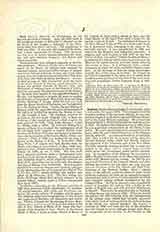

Jaca (JACCA), Diocese of (JACCENSIS), in the Spanish province of Huesca. Jaca, the chief town of the mountain district of Sobrarbe, is situated on the left bank of the Aragon, a tributary of the Ebro, about 2400 feet above sea-level. The population in 1900 was 4934. It was once the capital of the Jaccetani, a tribe mentioned by Strabo. This territory was the scene of battles between Sertorius and Pompey and later between Pompey’s son Sextus and Caesar’s generals.
Ecclesiastically Jaca belonged originally to the Diocese of Huesca. When in 713 the town of Huesca was seized by the Moors, its prelates were replaced by itinerant bishops, sometimes called bishops of Aragon, sometimes bishops of Huesca or Jaca, who lived either at Jaca or in the neighboring monasteries of San Juan de la Pena, San Pedro de Siresa, and Saasave. A council held at Jaca in 1063 determined anew the boundaries of the Diocese of Huesca, which thereafter included the present dioceses of Huesca, Jaca, and Barbastro, as well as a part of the Diocese of Lerida. Jaca was then made the permanent seat of the diocese. At the same time Sancho II was appointed Bishop of Huesca, and hastened to request the pope to confirm the decisions of the council. Meanwhile, however, King Sancho Ramirez of Aragon (1063-94) had won back from the Moors the city of Barbastro, and had granted ‘it to the Bishop of Roda. Garcia, the new Bishop of Huesca (1076-86), regarded this as an infringement of the rights of jurisdiction granted the Bishop of Jaca by the Council of Jaca. He therefore renewed his petition to the new pope (Gregory VII) to have the decisions of the council confirmed, which request the pope granted (cf. Jaffe, “Reg. Pont. Roman.”, I, 2nd ed., Berlin, 1885, n. 5098). As, however, Bishop Raimundo of Roda also obtained the confirmation of all his privileges from Gregory, a violent dispute arose between the Bishops of Huesca and Roda as to jurisdiction over the churches of Barbastro, Bielsa, Gistao, and Aiquezar, which in 1080 was decided by the king in favor of the Bishop of Roda. In November, 1096, King Pedro I of Aragon won back Huesca from the Moors, and Urban II now decreed (May 11, 1089) that, instead of Jaca, Huesca should again be the seat of the bishop (cf. Jaffe, op. cit., I, 5703). But Jaca itself had a separate existence under a vicar-general, independent of the Bishop of Huesca. It also retained its own cathedral chapter, which originally followed the Rule of St. Augustine, but in 1270 both this chapter and that of Huesca were secularized. Jaca was again erected into a separate diocese and was made suffragan to the Metropolitan See of Saragossa by a Bull of Pius V (July 18, 1571), which decision was carried into effect on February 26, 1572. The first bishop was Pedro del Frago, whose forty-second successor is the present bishop, Antolin Lopez y Pelaez (consecrated on April 4, 1905).
Statistics.—According to the diocesan statistics of 1907 Jaca possesses 73,659 inhabitants, 151 parishes, 151 parish churches, 236 public and 10 private oratories, 236 secular priests, 30 regulars, and 54 sisters. The religious orders and congregations in the diocese are: Augustinian Hermits, one monastery and novitiate; Piarists, 2 houses for the training of boys; Benedictine nuns, 1 convent and 18 professed sisters in the city of Jaca; Sisters of Mercy of St. Anna, who have charge of the hospital at Jaca; Sisters of the Sacred Heart of Mary, 1 house at Jaca; Sisters of Mercy of St. Vincent de Paul, with a school at Jaca, and the Little Sisters of the Aged Poor, with a home for the aged in a suburb of Jaca. The cathedral dedicated to the Most Blessed Virgin of Pilar is a three-aisled basilica in Byzantine style, belonging in the main to the eleventh century; it was consecrated in 1063 and altered in the fifteenth and eighteenth centuries. A religious and civil festival is still held on the first Friday of May; it is called “Primer Viernes de Mayo”, in memory of a victory said to have been won over the Moors in the eighth century by Count Aznar aided by the women of Jaca. It is celebrated with a solemn procession in which the entire cathedral chapter takes part. In the environs of Jaca are many hermitages, notably that of San Juan de la Pena. La Vergen de la Cueva is venerated in the same cave in which three hundred nobles gathered at the time of the Arab invasion and proclaimed Garcia Ximenez King of Sobrarbe.
GREGOR REINHOLD

